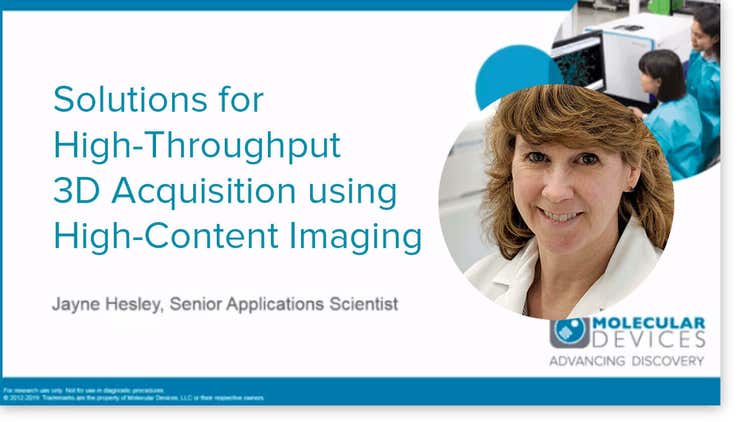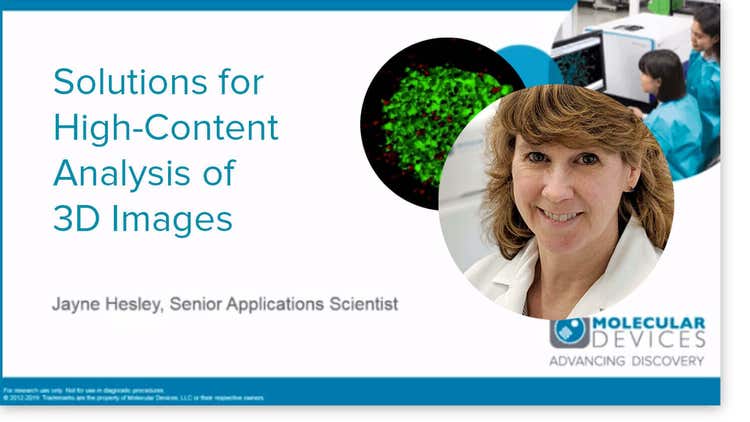
3D Cell Models
Investigate complex 3D biology using advanced methods
in cellular imaging and analysis technologies.
Cellular Imaging and Analysis for 3D Cell Culture Applications and Assays
Development of more complex, biologically relevant, and predictive cell-based assays for compound screening is a primary challenge in drug discovery. The integration of three-dimensional (3D) assay models is becoming more widespread to drive translational biology. Higher complexity cell models have gained popularity because they better mimic in vivo environments and responses to drug treatment. Specifically, 3D cell cultures offer the advantage of closely recapitulating aspects of human tissues including the architecture, cell organization, cell-cell and cell-matrix interactions, and more physiologically-relevant diffusion characteristics. Utilization of 3D cellular assays adds value to research and screening campaigns, spanning the translational gap between 2D cell cultures and whole-animal models. By reproducing important parameters of the in vivo environment, 3D models can provide unique insight into the behavior of stem cells and developing tissues in vitro.
3D cell imaging and analysis workflow
While the development of quantitative assays using 3D cell cultures has become an attractive investigative tool to understand complex biology, challenging 3D cell image acquisition and analysis workflows have hindered wider adoption by the screening community. High-content, high-throughput tools for microscopy offer innovative and automated techniques for evaluating this complex biology. After the 3D cell culture is grown or transferred to an imaging microplate, cells can be treated with compounds and stained with the marker of choice. For acquisition, the ImageXpress® automated imaging systems and our cellular imaging and analysis software provide the capability to screen and analyze these models within a single, integrated interface to dramatically reduce time to discovery.
Steps used for a typical 3D cell culture assay:

3D cell culture imaging and analysis techniques
Our imaging technology continues to evolve for easier implementation of more physiologically-relevant models. Learn more about how our technology can help scale-up 3D cell culture from small-scale assays to high-throughput screening.

Acquire images for 3D assays
In recent years, there have been significant advances in automated microscopy and imaging for delivering more predictive, physiologically-relevant measurements for drug discovery and environmental toxicity applications. Implementation of more complex assays and 3D models requires high resolution to capture publication-quality images and data.
Confocal imaging provides a high signal-to-noise ratio by reducing out-of-focus light for crisper images to yield more cellular detail even within a thick sample. Watch the video to learn about high-throughput techniques on how to acquire images in 3D using the ImageXpress Micro Confocal system.

Analyze images for 3D applications
There are different types of image sets that may be generated even though your sample is 3D. A single plane may be sufficient or multiple planes may be acquired. When multiple planes are acquired, it’s useful to be able to analyze them individually or to analyze them after combining them into a single 2D projection. Ultimately, analysis of the entire 3D image may be the goal of the experiment. Watch the video to learn more about techniques for analyzing images from multiple z-planes as a 3D volume using MetaXpress software.
Advantages of 3D Cell Models
Three-dimensional (3D) cell models are more physiologically relevant than two-dimensional cell cultures, and they more closely represent the tissue microenvironments, cell-to-cell interactions, and biological processes that occur in vivo. Now you can generate more predictive data using high-content imaging (HCI) systems like the ImageXpress system. By integrating both high-content image acquisition and analysis software like MetaXpress® software with the 3D Analysis Module, the ImageXpress system can be used for in-depth analysis, visualization, and assessment of 3D structures. This single interface will enable you to meet 3D acquisition and analysis challenges without compromise to throughput or data quality, giving you confidence in your discoveries.
Learn more about 3D cell model application and assays:
Latest Resources
3D cell imaging and analysis workflow
The workflow of a 3D cell culture protocol is dependent on the type of cell model being cultured. The 3D cell imaging and analysis workflow depicted here is a generalized example of 3D spheroids in a 96- or 384-well flat or round-bottom microplate. Each step breaks down the process from cell culture to image analysis and highlights the instrumentation and tools needed to conduct the cell culture protocol including an automated high-content imaging system and cellular imaging and analysis software.
Resources for 3D Cells
Related Products And Services
The ImageXpress automated imaging systems are the ultimate combination of speed, sensitivity, and flexibility in a turnkey solution for your 2D or 3D applications and can accommodate different types of slide and plate formats. Our ImageXpress imaging systems allow superior visualization of thick samples by minimizing background fluorescence and increasing sharpness, resulting in accurate image segmentation. Increase the biological relevance of your screening assays with a seamless integration between acquisition and analysis of cells in a 3D space to yield volume, intensity, and distance measurements.